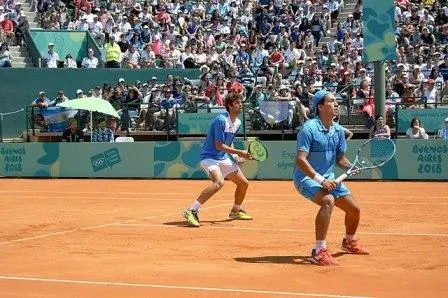
Next week I enter my first doubles tournament.
After playing for a couple of years now, I thought it was time I made the step up and started playing some more competitive tennis.
I also have a bit more time in July and August as I can play in the evenings and weekends, so now’s as good a time as any to get started.
This tournament is in a round robin format which means there’s a little less pressure so hopefully I can learn a lot over the next couple of months.
For some reason I’m my partner and I are in the higher of the 2 leagues (even though I haven’t entered a tournament before!) so I’m not sure how the organisers work it out!
So over the past few days I’ve been watching quite a few videos on the best doubles strategy to use.
There’s some great content on YouTube about this, particularly with the guys over at Essential Tennis and Top Tennis Training.
I’m generally better at the net than at the baseline, and my partner is stronger at the back so we’ll see how it goes.
For this blog post, I’m going to compile some of the useful doubles tips I’ve learnt, particularly those on positioning and playing style.
Positioning
Shading
This is fundamental to a successful doubles game. The video below highlights how you and your partner should effectively move with the ball whether that’s left or right, front or back.
For example, if your partner is pulled out wide, you should move towards the middle of the court
This is to ensure you cover the middle i.e. the space between you, which is a higher percentage shot for your opponent than a tightly angled cross court shot or drilling a shot down the line.
If they go for the riskier shots and hit a winner, sometimes you just have to say ‘Great shot!’
They can’t do it all the time 🙂
Get to the net
Try to get to the net as often as you can as that’s where most points are won in doubles.
Look for short balls, or if one of you hits a great shot deep in the opposing court. These situations will give you a great opportunity to get to the net.
Serving
Get your first serve in!
If you miss your first serve, your opponents get into a more attacking mindset and that puts you and your partner under greater pressure.
It is often worth taking a bit of pace off your serve to increase your first serve percentage. You can use the kick serve which will give you a bigger margin for getting your serve in, and you can mix things up with slice as well.
5 Tips On Shot Selection
Here are some useful things to consider when you’re placing your shots in a game.
1) Aim for the gap in between your opponents. It’s a higher percentage shot, as the ball will usually travel over the lower part of the net, and it can create confusion between them as to who should hit the ball. Aiming for tighter angles is a lot riskier.
2) Do more cross court return of serves than passing shots down the line. It’s a higher percentage shot and you are keeping the ball away from the opposing player at the net.
3) Aim at the feet of your opponents. They’ll have to hit up from that position which can set up a volley winner for you.
4) Target the weaker player more often. In the early exchanges in a match, study your opponents’ strengths and weaknesses. Do they have a weak backhand? Are they weak at the net? Do they struggle at the back of the court? Exploit their weaknesses.
5) Don’t go for power, especially with volleys and overhead shots. Too often players try to hit the killer shot and make an unforced error.
Communication
Talk to your partner in between points.
Be positive and encourage each other. Tell your partner “Good serve”, “Great shot” etc. It’ll give them more confidence.
Talk tactically aswell. If you’re serving, your partner should know where you’re going to place it.
If your partner is serving, they should know if you are going to switch, poach at the net, or fake and try to make your opponents hit down the line.

